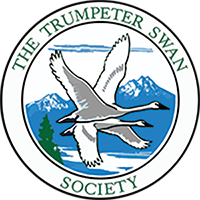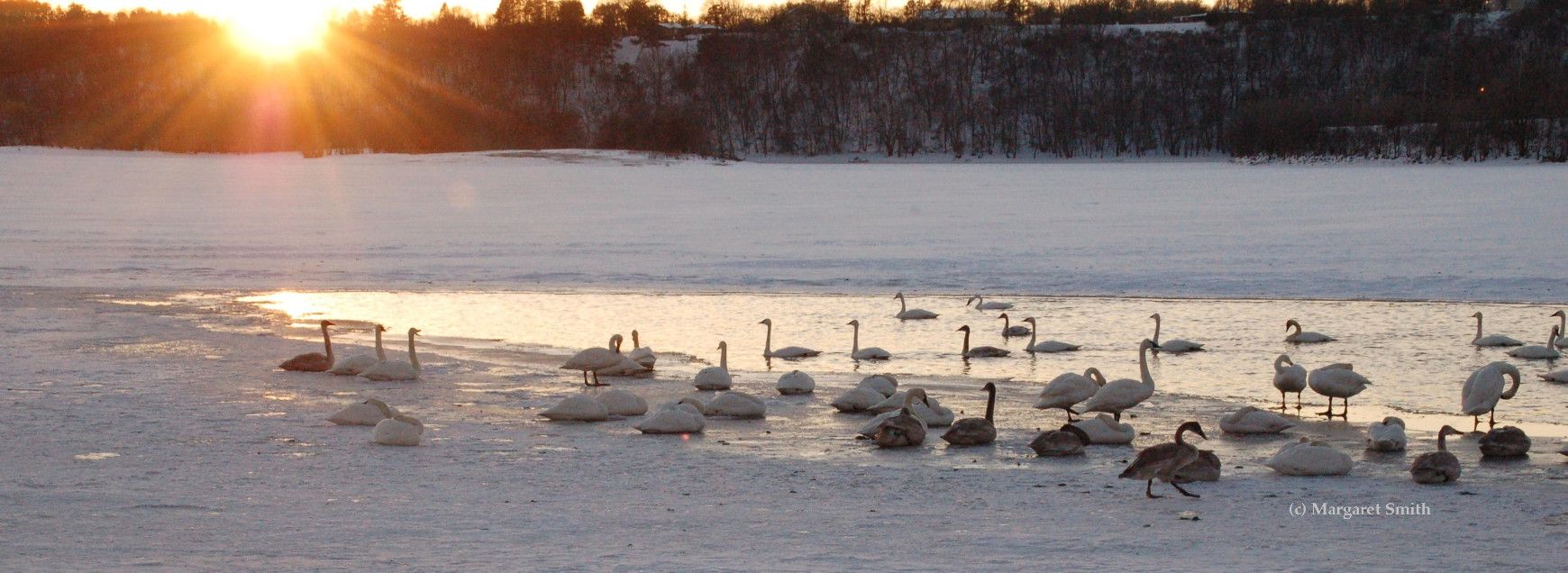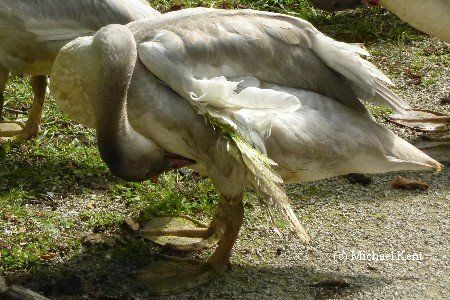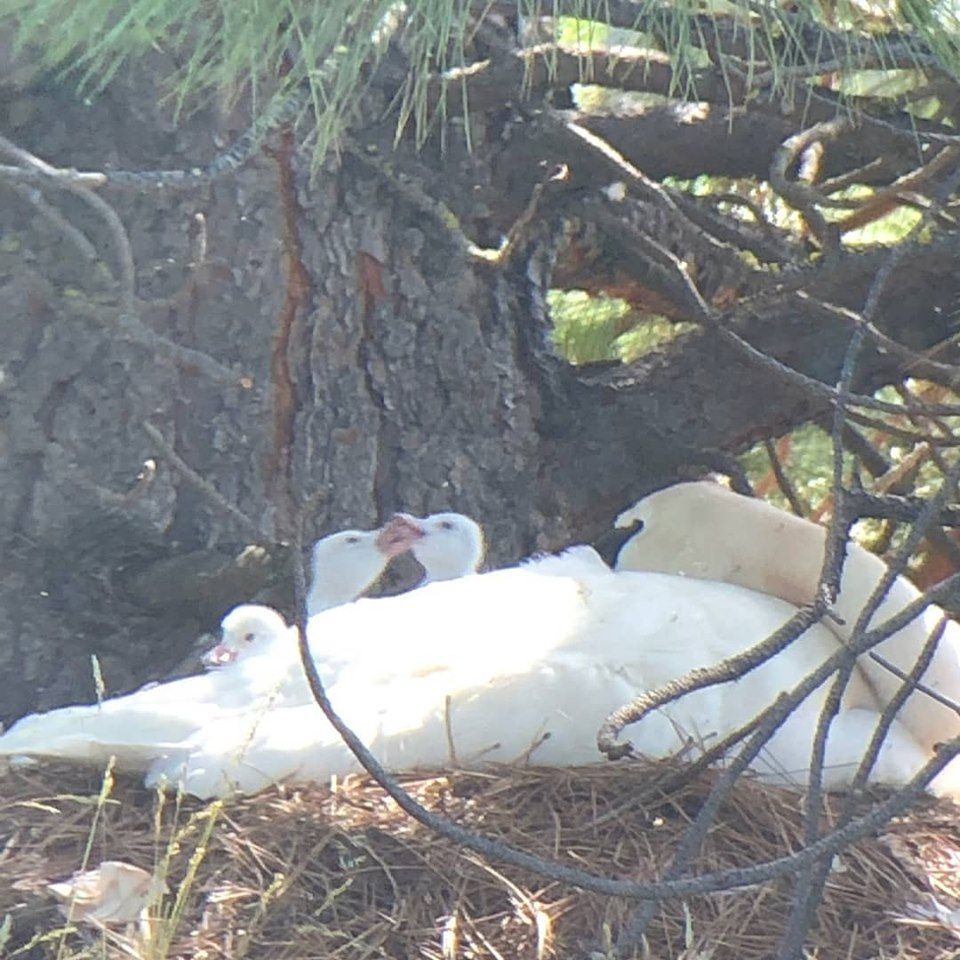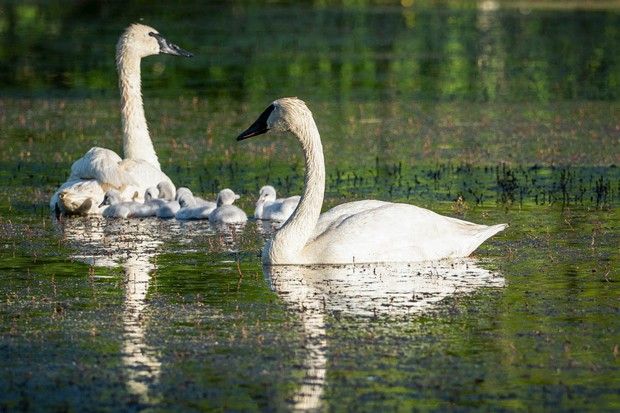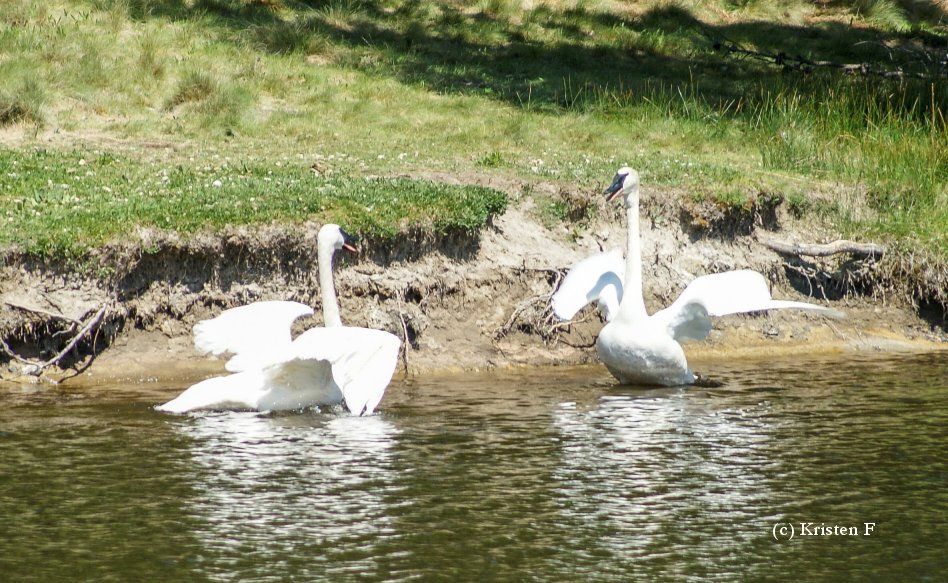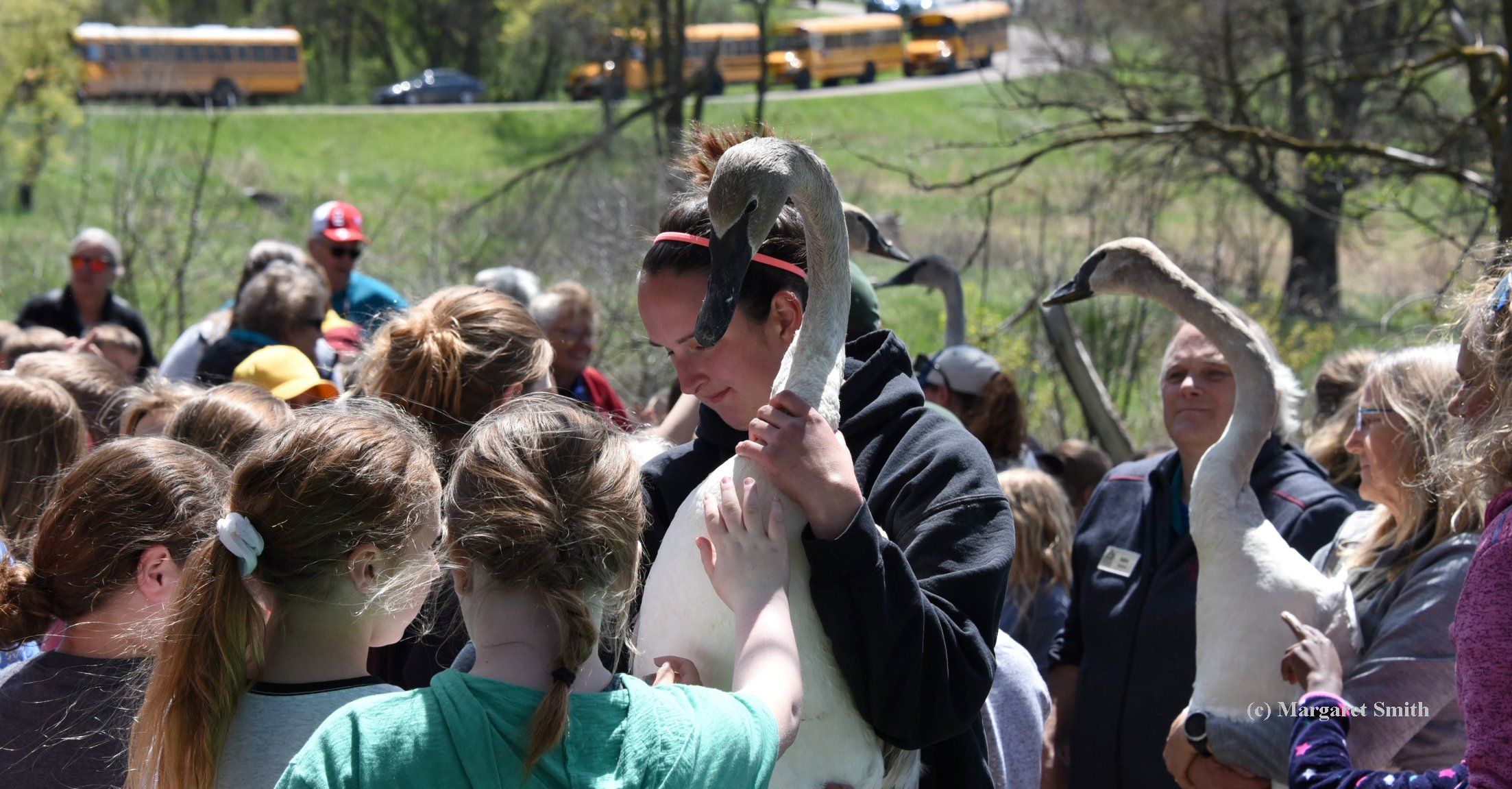Photograph by Margaret Smith
2019 TTSS News Archive
News Highlights from 2019
VIDEO: Here’s a quick trumpeter “swan smorgasbord’ of behavior. In less than a minute you can see preening, feeding, “tip up”, and take-off. You can also see and hear the “preflight” behavior of trumpeter swans getting ready to head off to the night’s roosting area.
Video by Margaret Smith, Executive Director, The Trumpeter Swan Society
BRITISH COLUMBIA: "While Trumpeter swans are not uncommon winter birds in the Southern Interior [Canada], it is not so easy to have them swim close enough to shore to get good photos."
“I've been watching the Trumpeter swans on Kalamalka Lake for the past few weeks,” Nick Clements posted on the Lake Country One Community Facebook Page on Christmas Eve. “Today they came close enough for a few photos.” Read more...
MONTANA: Lead Kills wildlife. Help prevent lethal doses of lead in birds on Flathead Reservation. Learn more...
IOWA: An Iowa man has been arrested for shooting six trumpeter swans at a marsh near Ankeny, Iowa. When questioned, he claimed that he thought the swans were geese. The DNR is thankful that a hunter called in the poaching incident in a timely manner.
The poacher has been charged with six counts of illegal taking of a nonprotected game and one count for an unplugged shotgun. His gun was taken by a DNR conservation officer and if convicted, could face a civil penalty of $1,500 per trumpeter swan. Read more...
ONTARIO: "A 'toxic' pond in Brampton has retired veterinarian Dr. Maureen Harper worried. Again. After a female trumpeter swan, known as Mama, died from lead poisoning from a pond near Heart Lake, Harper took it upon herself to contact the property owner, VANDYK, the Ministry of the Environment (MOE) and Peel Public Health to clean up the pond. That was a year ago. And Dr. Harper says very little has been done since." Read more...
IOWA: The Iowa Department of Natural Resources and Shelby County Conservation Boards’ Swans & S’mores will be held Saturday, Nov. 23 at 10 a.m. at Prairie Rose State Park. The second program will be on Saturday, Nov. 23 at 4 p.m. at Nishna Bend Recreation Area. The public is encouraged to attend one or both of these free programs to learn about Trumpeter Swans, their biology, and restoration efforts. Attendees will be allowed to feel the live swan. Following the program there will be a chance to make some S’mores. This swan will be arriving from the Maryland Zoo on Friday. On Monday it will be going to its winter home along with a swan from the Bronx Zoo. In the spring both of these swans will be released in Southwest Iowa. You also can have a chance to see the Bronx Zoo swan at Lake Anita State Park on Sunday, Nov. 24 at 2 p.m.
IOWA: "Three men have been charged after they shot a trumpeter swan in eastern Iowa, having mistaken it for a snow goose, authorities said...The men confessed when they were interviewed...The DNR said the swan has been preserved and will be displayed for education and outreach purposes...The citations are punishable by fines and fees totaling $322.50 for each man." Read more...
COLORADO: "A few decades ago, a trumpeter swan in Colorado would have been either amazing or a mis-identification of a tundra swan. The trumpeter population was too small for any to wander into Colorado. The population has grown, and now a trumpeter swan or two pass through Colorado almost every autumn. Just a few years ago, a trumpeter swan spent the winter on Lower Hoffman Lake just north of McKee Medical Center." Read more...
WASHINGTON: The Washington Department of Fish and Wildlife (WDFW) has re-established a hotline to report dead, sick, or injured swans in northwest Washington counties. This is part its ongoing effort to assess the impact of lead poisoning on trumpeter and tundra swans.
People can call (360) 466-4345, ext. 266, to report dead, sick or injured swans in Whatcom, Skagit, Snohomish, and other western Washington counties. Callers should be prepared to leave a short detailed message including their name, phone number, location, and condition of the swans. The hotline is available 24/7 through the end of March." Read more...
WYOMING: "November, and the natives are restless. So are their relatives from up north, tundra swans. Trumpeter swans and their more northerly kind, tundra (whistling) swans, are leaving or have left their summering and nesting quarters, heading for wintering grounds. Impressive numbers of each of these large, white waterfowl customarily spend some November days on waters in Jackson Hole, often at the north end of Jackson on Flat Creek. Several viewing spots permit observers (and photographers) great opportunities to admire, study and photograph swans on the National Elk Refuge." Read more...
NEW HAMPSHIRE: "It has been more than 200 years since a Trumpeter Swan has been seen here in the Granite State, until this spring, when the excitement at the Audubon headquarters was palpable. The buzz around the office was that there was a Trumpeter Swan being seen at the Abe Emerson Marsh in Candia." Read more...
MINNESOTA: "This morning their musical honking calls draw me to the shore of the small natural environmental lake bordering our farm. Yes, there they are, sounding like a symphony in brass—our pair of trumpeter swans in gleaming white plumage with two dusky gray cygnets by their side. Soon they, too, will be migrating." Read more...
MINNESOTA: "Waabiziiwag giiwewag, "the swans return home." This work to restore some of the original dignity of this land and waters is the work of a lot of people and agencies who are often not acknowledged. These birds were returned from the brink of extinction because they were classified as a non-game species. They were restored because people worked together, and the swans wanted to come home. They are some pretty noble creatures.
As I pass the shores of Shell Lake, I often stop to put my tobacco out in prayer for the wonders of the north country, and the headwaters of the Mississippi, home of the Waabiziiwag. Their homecoming has been long awaited. " Read more...
ALBERTA: "A trio of swans was flying directly overhead. They’d just lifted off from a group of maybe 50 or so of their siblings and cousins, running across the water and flapping their huge wings to get airborne. Rising into the air, they banked and headed off southwest, bleating out farewells to the birds they’d left behind — or maybe just telling each other to watch how they were flying — and heading toward the truck." Read more...
MONTANA: "The Bitterroot Valley’s first trumpeter swan cygnets born in the wild are now large enough to fly...The cygnets are the first documented wild trumpeter swans hatched in the Bitterroot Valley since restoration efforts started decades ago to bring the birds back from the brink of extinction in the lower 48 states." Read more...
That is a question we receive at The Trumpeter Swan Society. Feeding young swans "human food" or food that is rich in protein and calories can also contribute to "angel wing" during their growth, a deformity of the wings which can permanently prevent a swan from flying.
Here is a video by Michael Kent of a swan cygnet that has “angel wing” on both wings. See what feeding young swans "human food" can lead to...
IDAHO & WYOMING: The Upper Snake River region will receive $1 million to protect and enhance 1,691 acres of migrating, breeding and wintering habitat. The funding will specifically target improvements to benefit trumpeter swan, northern pintail and mallard ducks. Another project will permanently protect 785 acres, while restoring 2,370 acres and enhancing 563 acres in Western Wyoming. Read more...
WISCONSIN: A Century Ago, There Were No Trumpeter Swans Left In Wisconsin, Today Their Numbers Reach 6K. Wisconsin Public Radio shares the story of the beginnings of Wisconsin's trumpeter swan restoration thirty years ago. Flights to Alaska to collect eggs in wild swan nests, to hatching the eggs at zoo partners, the return of trumpeter swans to Wisconsin is a story of adventure, dedication and persistence. Read more...
MONTANA: Five Trumpeter Swan cygnets were released into the Blackfoot Valley at Jones Lake on the Rolling Stone Ranch. "Greg Neudecker, a biologist with the U.S. Fish and Wildlife Service, explained to about 150 people gathered at the edge of the lake that after 15 years, they’re close to concluding the efforts to re-establish trumpeter swans in the Blackfoot watershed... for three years, the U.S. Fish and Wildlife Service took eggs from nests in Canada, where the trumpeter swan population was thriving. They had a strategy; usually, trumpeter swans lay four to seven eggs. Neudecker’s group would leave two that were fertile and take the rest.
“We gathered 60 eggs for three years in a row,” he said. “Then we took them to Jackson Hole, Wyoming, to hatch, then brought them here and released them...So far, the Fish and Wildlife Service and a host of partners have released 250 trumpeter swans in the Blackfoot Valley in the past 15 years, with a goal of seven successful nesting pairs for two consecutive years in a row.” Read more...
WISCONSIN: Wisconsin Natural Resources Magazine takes a fascinating look back at the story of the return of trumpeter swans to the state. "RESEARCHERS REWIND 30 YEARS TO TELL THEIR FIRST-PERSON TALE OF SECOND CHANCES FOR AN ESTEEMED SPECIES."
"The plan was to collect eggs from the wilds of Alaska to be hatched at the Milwaukee County Zoo. The young would be reared in captivity and in the wild before they were released. DNR research scientists, wildlife managers and technicians were involved along with participants from the zoo, UW-Madison and scores of organizations and individuals.
In spring 1989, three years after the state set a recovery goal of 20 breeding and migratory trumpeter swan pairs by the year 2000, we prepared to go to Fairbanks, Alaska, our launch point west toward the vast wetland complex known as the Minto Flats. This was where the first of our Alaskan trumpeter swan egg collections would occur." Read more...
IDAHO STATE UNIVERSITY: Idaho State University biological sciences master’s student Paige Miller has continued ISU research of Southeast Idaho Trumpeter Swans this summer by using remote cameras and placing tiny thermometers inside of empty egg shells...The cameras allow researchers to monitor the swans 24-hours-a-day, seven-days-a-week, to investigate swan incubation constancy across the refuges. “Setting up the camera systems on the nest and being able to review the footage, we get to see swans from right after they laid the eggs, to the incubation and maintenance of the nest, to hatching the eggs to teaching their cygnets (baby swans) on how to be a swan and survive." Read more...
MONTANA:
Hatched in mid June, Lee Metcalf National Wildlife Refuge's cygnets are thriving. The cygnets are the first documented wild trumpeter swan cygnets hatched in the Bitterroot Valley since restoration efforts began decades ago to bring the huge majestic birds back from the brink of extinction in the lower 48 states. Read more...
MINNESOTA: A Lino Lakes man was sentenced to 90 days in jail Wednesday after he pleaded guilty to killing two federally protected trumpeter swans. Read more...
OREGON:
"Across the state, biologists count 17 baby swans this breeding season, the same number as last year. But there are at least four other nests with eggs that could hatch, potentially making this the most successful breeding season in recent memory. The increase is a sign the species is recovering from being hunted to near-extinction around the turn of the 20th century, when no swans remained in Oregon. Today, about 35 trumpeter swans live year-round in Oregon. " Read more
OREGON: Sunriver. “It’s been a great year for Central Oregon swans”
"Sunriver Nature Center staff can’t believe the odds. Exactly two years since four baby trumpeter swans hatched on the Fourth of July, another four fuzzy heads appeared Thursday from their mother’s nest on the nature center’s Lake Aspen. Two pairs of trumpeter swans, Gracie and Gus and the Sisters' swan pair, Eloise and Pete, are part of the state’s breeding program that is trying to help repopulate the once threatened species. The protected species is still slowly recovering after being hunted to near-extinction in the early 1900s, when none remained in Oregon. Today, about 35 trumpeter swans live year-round in Oregon." Read more...
MONTANA:
"Lee Metcalf National Wildlife Refuge project leader Tom Reed spotted two trumpeter swan cygnets Monday morning, June 24, 2019. The cygnets are the first documented wild trumpeter swan cygnets in the Bitterroot since restoration efforts for the nation's largest native waterfowl began decades ago." Read more...
OREGON: Not Singing the Swan Song.The tales of two trumpeter couples in Central Oregon. There is happy news in Oregon as our partnership trumpeter swan breeding pair at Aspen Lakes Golf resort in Oregon hatched 8 cygnets! The pair met last year and hatched one cygnet which was released at Summer Lake Wildlife Area this spring. This summer the happy pair welcomed a very large number of cygnets. Read more...
MINNESOTA: A 25-year-old Lino Lakes man shot and killed two federally protected trumpeter swans as he sat in a kayak on a suburban Anoka County lake, according to charges. A DNR officer saw the man trail one of the birds as it swam and then kill it with a shotgun blast, according to the charges. Read more...
OREGON: The Oregon Restoration Program has a male new swan at Sunriver Nature Center in Oregon. On Thanksgiving Day, 2017, the male breeding swan "Chuck" was illegally shot and killed. The Trumpeter Swan Society purchased "Sir Charles aka Chuck" from Kellogg Bird Sanctuary in Augusta, Michigan. The new male swan who arrived in Oregon in early May also came from Kellogg Bird Sanctuary (KBS), having been an injured wild swan rehabilitated at Kellogg Bird Sanctuary. He instantly bonded with "Grace" the female swan and are now awaiting the hatch of their two eggs. Read about the new male swan's name, which honors KBS and also means "revered" ...
MONTANA: Montana's Centennial Valley, west of Yellowstone National Park, is known to millions of school children who read E.B. White's, "Trumpet of the Swan." Kristen Inbody of The Great Falls Tribune shares how ranching, a refuge and a beloved children's novel are part of the fabric of isolated valley. It includes beautiful photographs, a short video of trumpeter swans in the valley, and fine storytelling (plus maps). Read more...
MONTANA:
"For as long as most anyone alive can remember, the Bitterroot Valley hasn’t reared a single trumpeter swan cygnet. That might change this summer. On a remote pond at the Lee Metcalf National Wildlife Refuge, a pair of trumpeter swans have built a nest on top of a muskrat lodge. Read more...
OREGON
Our Oregon Restoration Project had great news! "At last, Gracie will have a second chance at love.
The adored trumpeter swan at the Sunriver Nature Center has been alone since losing her mate, Chuck, on Thanksgiving Day in 2017, when he was illegally shot and killed by a young hunter on the Deschutes River northwest of Sunriver.
But on Monday, she was introduced to a new mate, who was transported from the W.K. Kellogg Bird Sanctuary in Southwest Michigan." Read more...
IOWA: Share in the excitement of hundreds of Iowa students who came to learn about trumpeter swans and watch their release three Iowa locations. Watch this 30 second video posted on TTSS's Facebook page.
Twenty trumpeter swan cygnets were the “stars of the show” at this year’s southern Iowa swan releases in early May. The nearly-one-year-old cygnets were donated from zoos in Cleveland, Kansas City, Green Bay, Oklahoma City, Bronx, Anchorage, Southwick (Massachusetts), Topeka, Omaha and Maryland.
Eight of the trumpeter swan cygnets were released at Iowa’s Lake Anita State Park. Hundreds of enthusiastic Iowa students, teachers, and the public came to see the release and learn about trumpeter swans...
MONTANA: "Watching this trumpeter once again reminded me of how important conservation properties like Teller are by providing undisturbed stopover habitat for species like the trumpeter. Even if it was just a few days, the resting and foraging habitat provided to this bird will ensure that it will depart to Canada or Alaska in good shape. My hope is that this bird returns next year with a mate to consider raising a brook on Teller." Read more...
YUKON
Yukon's Celebration of Swans six week event attracts 10% of the provinces population. Record numbers of swans are now showing up.
Every spring, migrating swans rely on the the ice-free water of M'Clintock Bay in Marsh Lake as a place to feed and rest. Yukoners then flock to the Swan Haven Interpretive Centre to view the birds from a distance.
COEUR D'ALENE, Idaho - A noticeable amount of dead tundra swans have been reported in the lower Coeur d’Alene River Basin, resulting from what the Idaho Department of Fish and Game is attributing to mine waste contamination.
According to the Department of Fish and game, around 95 percent of wetland habitat in the lower Coeur d’Alene River Basin contains levels toxic to waterfowl. Read more...
The New York Times shares the successes of trumpeter swan restoration, the dedication of people who made it happen, and continuing regional issues trumpeter swans still face, in this fascinating article written by Karen Weintraub. From sea to shining sea, trumpeter swans are making a comeback. Read more...
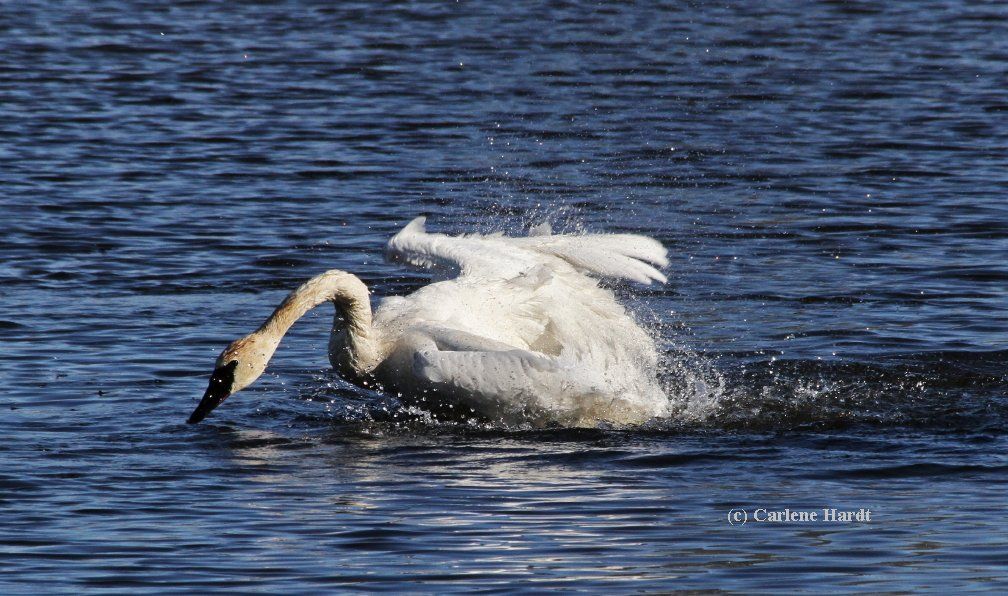
My Swan Story by Carlene H.
TURNBULL NATIONAL WILDLIFE REFUGE, WASHINGTON
BARREL ROLL
When was the last time you saw a dirty swan?
On March 22nd at Turnbull National Wildlife Refuge I was thrilled to watch this Trumpeter swan diving underwater and then doing barrel rolls at the surface of the water. Swans are so buoyant I am amazed that most of their body can be underwater!
When it popped up out of the water it repeatedly slapped its wings on the water for lots of splashes. I couldn’t help but think that not only was it getting a good bath but it was having fun doing it!
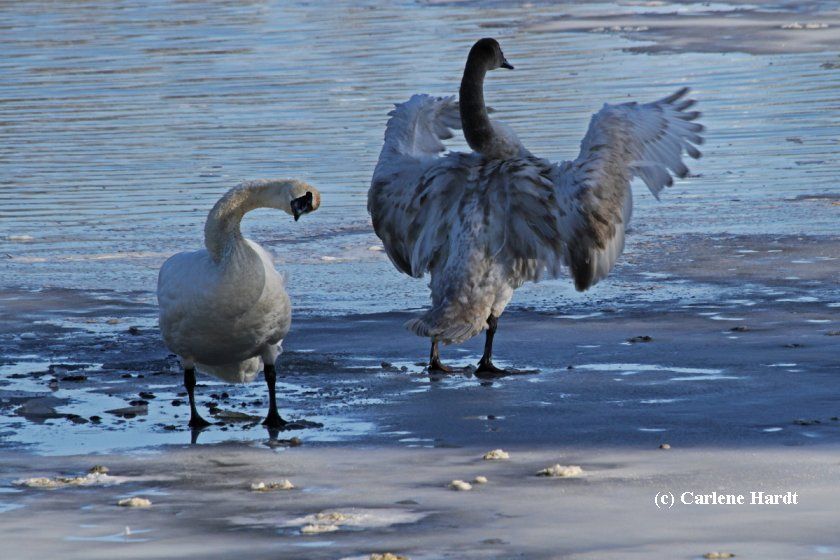
My Swan Story by Carlene H.
TURNBULL NATIONAL WILDLIFE REFUGE, WASHINGTON
PRETZEL NECK
After it warmed up from a cold, icy winter, I decided to go out to Turnbull National Wildlife Refuge to see if migration was happening. To my delight, I counted 15 swans coming through that day. There was a family of 6 Trumpeters that were bathing in the water and then taking turns coming up on a small patch of ice to finish preening.
I captured this image of an adult swan looking right at my camera, which I thought was humorous! At the same time its cygnet was stretching its mottled tan and white wings. Soon the cygnet will be pure white! What a special time to watch all the swan activity that day!
Minnesota: "Dead trumpeter swans found at Sucker Lake in Vadnais Heights earlier this month died of lead poisoning, according to a University of Minnesota diagnostic lab report...About 10 dead swans were found at Sucker Channel, six at Peltier Dam in Lino Lakes, five at Pickerel Lake in Lilydale, four at Grass Lake in Stearns County, and at least two were found in Little Pine Lake in Ottertail County...at least 50 trumpeter swans swimming on the lake and in the channel in March. Lead poisoning has been an ongoing issue for conservationists in the state." Read more...
Minnesota: The Department of Natural Resources announced on April 1 that a $500 reward is now being offered for information that leads to an arrest in a poaching case that took place in Douglas County last week...The DNR got reports of a doe and a yearling whitetail being shined and shot late in the evening on March 25. A trumpeter swan was shot on the water near the same location the next morning. There was no attempt to retrieve any of the animals. Read more...
HOT SPRINGS VILLAGE, ARKANSAS: Hot Spring "Village bird watchers have had a rare treat the last week or so. HSV Audubon received a call on Feb. 17 that a swan had been sighted on Lake Sophia.A picture of the bird confirmed that it was a Trumpeter Swan. Even though it didn’t stay long, a Trumpeter was reported the next day at nearby Lake Maria. Read more..."
IDAHO: Deer Park Wildlife Mitigation Unit. "An estimated one-fourth of the Rocky Mountain trumpeter swan population is wintering at a nearby wildlife area near Menan Buttes and it’s drawing looks from local bird-watchers. An estimated 3,000 swans as well as hundreds of ducks and geese have gathered at the Deer Park Wildlife Mitigation Unit just west of the buttes." Read more...
ONTARIO: Listen to the 20 minute broadcast of the story of the return of trumpeter swans to Ontario. Or, read the article and watch the slide show...
Researchers with the U.S. Fish and Wildlife Service at three southeast Idaho National Wildlife Refuges are trying to determine why the native bird’s young have been having trouble surviving in recent years. Read more...

My Swan Story by Carlene H.
My husband and I went out to Turnbull National Wildlife Refuge in Cheney, Washington on Saturday February 2nd because it was a warm 40 degrees and in the next few days we were going to be in the deep freeze! As soon as we walked up the trail, we heard the powerful flapping of wings overhead and then looked up and saw a pair of Trumpeter swans flying in and landing near us on Middle Pine Lake. They preened a little bit and then swam around to eat. Parts of the lake were frozen but most of it was not. There were times when the sky was blue and it made you forget it is winter! I stood still for awhile and they got very close. It was nice to see such loveliness in winter.
OREGON: The Trumpeter Swan Society has partnered with the Oregon Department of Fish and Wildlife and the U.S. Fish and Wildlife Service to build a healthy Oregon breeding flock; releasing birds at Summer Lake Wildlife Area, which is a good place for bird watchers to see them. Good news is that trumpeter swans are migrating through Oregon, and February is a good month to spot them among the vast tundra swan flocks moving through the Klamath Basin. Read about their comeback to North America, the challenges they face, and the what is being done to help their return...
ONTARIO: "Fishing in Hamilton Harbour has become extremely popular in recent years. Are anglers leaving behind highly toxic lead that is poisoning wildlife?" Read more...
ONTARIO: Five dead swans were picked up by Hamilton Animal Services between Dec. 10 and Jan. 10, adding to a list of strange avian deaths involving trumpeter swans and juvenile eagles. The development is significant because harbour scientists fear swans, bald eagles, and possibly other large birds are being exposed to lead either from historic harbour contamination, lead shot from hunters, lead sinkers used in fishing or from another source. Read more...
"The provincial minister of Forests, Lands, Natural Resource Operations and Rural Development made the comment in a press release announcing that the wetlands just north of Duncan are the province’s newest wildlife management area.
“Wildlife management areas help to meet government’s mandate to sustainably manage B.C.’s ecosystems, rivers and lakes, as well as improving wildlife management and habitat conservation,” Donaldson said.
The unique wetland is home to more than 200 species of birds including but most certainly not limited to a massive trumpeter swan population and great blue herons. It’s also home to the rare Garry oak ecosystem and is a significant fish and wildlife habitat as well. Read more...
